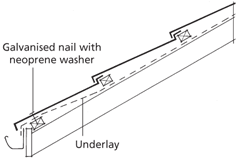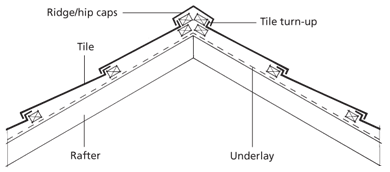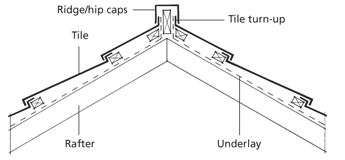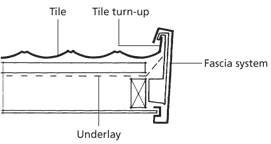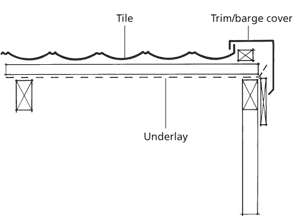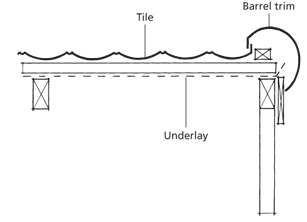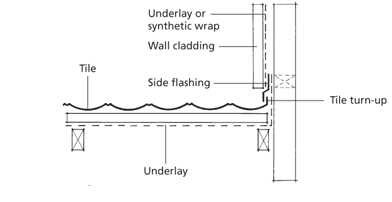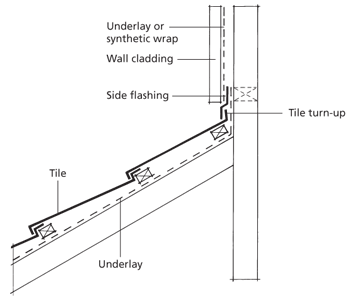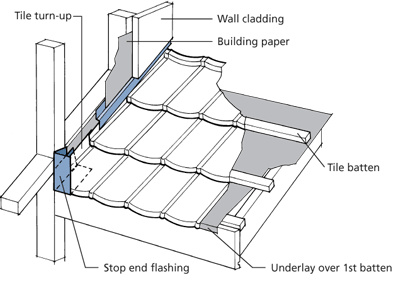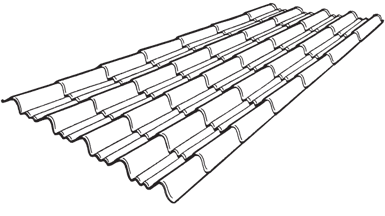COP v25.03:Other-Products; Pressed-Metal-Tiles
The principles behind detailed requirements for fixings, flashings, corrosion, compatibility, and maintenance as described elsewhere in this COP should also be applied to the design and installation of pressed metal tiles.
Exceptions result from the specific differences between tiles and other forms of metal roof cladding, and include the height of laps and specific dimensions of metal shingles and shakes prescribed in this section.
Tiles with a minimum upstand of 25 mm must not be laid on roof structures less than 12° unless approved in writing by the tile manufacturer, the B.C.A. or the Territorial Authority.
Tiles, shakes or shingles with an upstand of less than 25 mm must not be laid on roof structures less than 15°.
N.B. The pitch of the roof is not the same as the pitch of the tiles because this varies with the height of the batten and the height of the upstand. If the minimum pitch cannot be complied with, a method approved in writing or a producer statement should be given before work is commenced.
The first length of underlay should be positioned so that it lays over the eave batten and the fascia, and into the gutter.
When pressed metal tiles are installed, the underlay is laid horizontally on top of the rafters before the battens are fixed, and so there is an air space between the underlay and the tiles, except at the eave.
Roof framing should provide support and fixing for the tile battens that will satisfy the design load wind requirements. Installers should check that the framing has been erected to an accurate and even line before roof fixing is started.
- H1.1 boric treated when used in attic roof construction;
- H1.2 treated when used in skillion roof construction;
- Douglas fir with a moisture content of less than 20%;
- KD Pinus Radiata with a moisture content of less than 18%;
- a minimum of 50 mm x 40 mm for 900 mm rafter spacing; and
- a minimum of 50 mm x 50 mm for 1200 mm spacing.
N.B. Battens at different centres may require different values.
15.3.1.5A Batten Installation
- Battens must have square cut ends and must be butt jointed over the centre line of the rafter.
- Adjacent rows of battens must not be joined on the same rafter and must span at least three rafter spacings at the roof edge.
- A batten must be installed immediately behind the fascia as fixing for the eaves tiles.
- Eaves tiles must overhang the gutter by a minimum of 30 mm.
Eaves tiles are recommended to overhang the gutter by 40 mm.
Because an eaves-tile batten is installed immediately behind the fascia the position of the next batten up the rafter will be less than that of the normal tile batten spacing. The position of this batten may vary depending on the pitch of the roof.
The edge of the roof should be taken as 20% of the roof width measured from the fascia, barge, hip or ridgeline, and will apply all around the periphery of each roof plane.
The batten layout is marked on the rafters by placing nails at the line of the batten fronts. The roofing underlay is laid over this, onto the rafters. The battens are then laid from the lowest part of the roof upwards, using the marker nails to locate the front edge of the batten. The marker nails are removed before the tiles are laid.
15.3.1.5.1A Pullout resistance in kN required for battens for buildings with ceilings
cpe = -0.9, cpi = 0, cp = 0.9
| Purlin/ batten size | Max span | Wind Zone 0.61kPa | Wind Zone 0.61kPa | Wind Zone 0.82kPa | Wind Zone 0.82kPa | Wind Zone 1.16kPa | Wind Zone 1.16kPa | Wind Zone 1.50kPa | Wind Zone 1.50kPa |
|---|---|---|---|---|---|---|---|---|---|
| mm x mm | mm | Low 32m/s | Low 32m/s | Medium 37m/s | Medium 37m/s | high 44m/s | high 44m/s | Very high 50m/s | Very high 50m/s |
| M | P | M | P | M | P | M | P | ||
| 50 x 40 | 900 | 0.2 | 0.3 | 0.3 | 0.4 | 0.3 | 0.5 | 0.5 | 0.7 |
| 50 x 50 | 1200 | 0.2 | 0.4 | 0.3 | 0.5 | 0.5 | 0.7 | 0.6 | 0.9 |
15.3.1.5.1B Pullout resistance in kN required for buildings without ceilings (but with a permeable
windward wall)
cpe = -0.9, cpi = 0.2, cp = 1.1
| Purlin/ batten size | Max span | Wind Zone 0.61kPa | Wind Zone 0.61kPa | Wind Zone 0.82kPa | Wind Zone 0.82kPa | Wind Zone 1.16kPa | Wind Zone 1.16kPa | Wind Zone 1.50kPa | Wind Zone 1.50kPa |
|---|---|---|---|---|---|---|---|---|---|
| mm x mm | mm | Low 32m/s | Low 32m/s | Medium 37m/s | Medium 37m/s | high 44m/s | high 44m/s | Very high 50m/s | Very high 50m/s |
| M | P | M | P | M | P | M | P | ||
| 50 x 40 | 900 | 0.2 | 0.3 | 0.3 | 0.5 | 0.4 | 0.6 | 0.6 | 0.8 |
15.3.1.5.1C Pullout resistance in kN required for buildings without ceilings (and with a dominant
windward opening)
cpe = -0.9, cpi = 0.8, cp = 1.7
| Purlin/ batten size | Max span | Wind Zone 0.61kPa | Wind Zone 0.61kPa | Wind Zone 0.82kPa | Wind Zone 0.82kPa | Wind Zone 1.16kPa | Wind Zone 1.16kPa | Wind Zone 1.50kPa | Wind Zone 1.50kPa |
|---|---|---|---|---|---|---|---|---|---|
| mm x mm | mm | Low 32m/s | Low 32m/s | Medium 37m/s | Medium 37m/s | high 44m/s | high 44m/s | Very high Very high 50m/s 50m/s | |
| M | P | M | P | M | P | M | P | ||
| 50 x 40 | 900 | 0.4 | 0.5 | 0.5 | 0.7 | 0.7 | 1 | 0.9 | 1.3 |
| 50 x 50 | 1200 | 0.5 | 0.7 | 0.6 | 0.9 | 0.9 | 1.3 | 1.1 | 1.7 |
15.3.1.5.1D Tile Batten Fastener Requirements
| Fastener | Size | No. | kN |
|---|---|---|---|
| Gun nail | 90 x 3.15 | 1 | 0.4 |
| Ringshank nail (gun/hand) | 90 x 3.2 | 1 | 0.6 |
| Gun nail | 90 x 3.15 | 2 | 0.7 |
| Twist Shank Nail | 90 x 3.3 | 1 | 0.9 |
| Purlin Screw c/s head | 10g x 100 | 1 | 2.5 |
| Type 17 screw | 14g x 100 | 1 | 7.3 |
Where secret gutters are used or where the flashings are unseen, they must have a durability of 50 years.
The valley must have a minimum upstand of 20 mm, and the fasteners must not penetrate the valley.
For valley sizing, see 5.5.7 Valley Capacity Calculator.
Metal Tiles are classified as a Type B roof cladding as they cannot be walked on indiscriminately without the risk of damage.
Standard flashings are supplied for most locations on a roof, and are in two styles, only one of which is used on any one roof. All flashings and roofing accessories are made of the same base metal as the tiles.
- Long accessories are 2 m long with fixing holes every 500 mm and there are specific accessories for ridges, hips, barges, aprons and walls.
- Short accessories are 400 mm long trims and can be used for most flashing applications on a roof.
Special flashings are made as required by the manufacturer or the roofer from uncoated steel, and subsequently factory coated using the same coating process as used for tiles.
Ridge tiles are bent up and then cut to form a turn-up that fits under the ridge/hip cap or short accessory. To ensure a watertight joint, a tight fit is required between the tile and the ridge cap.
Tiles should be turned up against the battens or hip board by a minimum of 40 mm. See 15.3.5.1A Ridge and Hip: Short Trim Installation and 15.3.5.1B Ridge and Hip: Long Trim Installation.
Tile ends are turned up a minimum of 40 mm and installed against a batten that will be covered by a barge cover or under a metal fascia. If a hidden gutter is used, tile edges should be turned down into the gutter by a minimum of 20 mm.
Flashings at the ends of roofs, where the roof does not end past the wall require a stop-end flashing that ensures water is directed into the gutter. Sufficient material should be left standing out from the wall so that cladding installers can ensure a weatherproof finish.
Tiles cut for penetrations through the roof should be provided with up-stands and over-flashed for drainage from above without restricting the water flow.
The flashing should finish 15 mm beyond the tile head lap above the penetration and should be wide enough to cover the nearest tile rib or up-stand. When the construction is solid masonry or brickwork, and flashings cannot be installed under the wall cladding, a chase should be cut and an over-flashing installed in the chase to provide weather protection.
A long-run tile is a hybrid roof cladding providing the appearance of pressed metal tile with the fixing attributes of long-run profiled metal cladding.
The minimum pitch is 8˚, and underlay and battens are fixed in the same manner as for pressed metal tiles.
The module or step size of the profile can be adjusted, and the pitch of the tile can be varied to suit any batten spacing on an existing roof or to alter the roof appearance.
Maximum sheet length is 7 m however transverse laps are possible.
The material is pre-painted metallic coated steel with a yield strength of G250 Mpa. It is fixed with nails or screws at the front of the tile.
Sheets should be back-laid, working from right to left which prevents creep at the gutter line due to the back-step in the underlap of the profile.
Longrun tile can be curved to a 250 mm radius.
The requirements of 13 Site Practice also apply to the installation of metal tiles. In addition all gutters, valleys, roof channels and the roof should be left clean and free from debris on completion of the work.
The roofing supervisor will establish when the roof should be installed after all sub-trade work has been completed.
If substantial work, such as texturing walls, is to be carried out on a wall above or adjacent to where metal tiles are to be laid, they should be installed after such work has been completed.
Tiles should be inspected and selected, as tiles of a different colour match should not be installed on the same plane of a roof. If more than one pallet of tiles is required for one job, the colour uniformity should be checked.
Tiles should be laid from the ridge down to avoid unnecessary traffic and can be laid broken bond or straight down the roof.
The eave gutter tiles should project over the edge of the fascia to ensure that water discharges directly into the gutter system and tiles should be laid so they prevent any water penetrating into the roof cavity.
Before tiles are laid, the direction of lay should be determined by:
- Taking into account whether the profile can be laid only one way or both ways;
- Appearance, so that laps face away from the line of sight;
- Allowing for prevailing weather exposure.
Installation of perimeter tiles (excluding eaves tiles) can be completed before the main body of tiles are laid.

